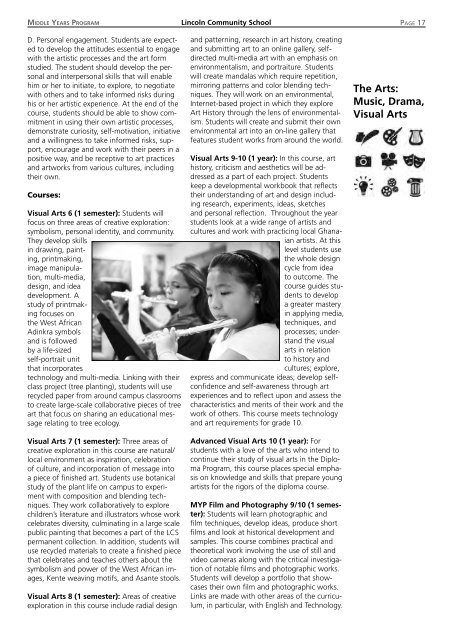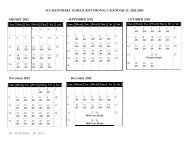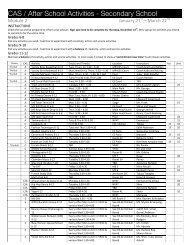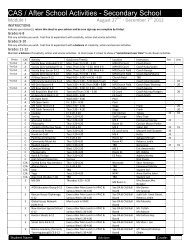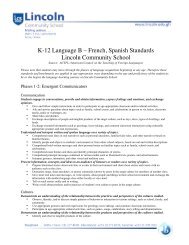MYP Programme Guide - Lincoln Community School
MYP Programme Guide - Lincoln Community School
MYP Programme Guide - Lincoln Community School
You also want an ePaper? Increase the reach of your titles
YUMPU automatically turns print PDFs into web optimized ePapers that Google loves.
Middle Years Program<br />
<strong>Lincoln</strong> <strong>Community</strong> <strong>School</strong><br />
Page 17<br />
D. Personal engagement. Students are expected<br />
to develop the attitudes essential to engage<br />
with the artistic processes and the art form<br />
studied. The student should develop the personal<br />
and interpersonal skills that will enable<br />
him or her to initiate, to explore, to negotiate<br />
with others and to take informed risks during<br />
his or her artistic experience. At the end of the<br />
course, students should be able to show commitment<br />
in using their own artistic processes,<br />
demonstrate curiosity, self‐motivation, initiative<br />
and a willingness to take informed risks, support,<br />
encourage and work with their peers in a<br />
positive way, and be receptive to art practices<br />
and artworks from various cultures, including<br />
their own.<br />
Courses:<br />
Visual Arts 6 (1 semester): Students will<br />
focus on three areas of creative exploration:<br />
symbolism, personal identity, and community.<br />
They develop skills<br />
in drawing, painting,<br />
printmaking,<br />
image manipulation,<br />
multi-media,<br />
design, and idea<br />
development. A<br />
study of printmaking<br />
focuses on<br />
the West African<br />
Adinkra symbols<br />
and is followed<br />
by a life-sized<br />
self-portrait unit<br />
that incorporates<br />
technology and multi-media. Linking with their<br />
class project (tree planting), students will use<br />
recycled paper from around campus classrooms<br />
to create large-scale collaborative pieces of tree<br />
art that focus on sharing an educational message<br />
relating to tree ecology.<br />
Visual Arts 7 (1 semester): Three areas of<br />
creative exploration in this course are natural/<br />
local environment as inspiration, celebration<br />
of culture, and incorporation of message into<br />
a piece of finished art. Students use botanical<br />
study of the plant life on campus to experiment<br />
with composition and blending techniques.<br />
They work collaboratively to explore<br />
children’s literature and illustrators whose work<br />
celebrates diversity, culminating in a large scale<br />
public painting that becomes a part of the LCS<br />
permanent collection. In addition, students will<br />
use recycled materials to create a finished piece<br />
that celebrates and teaches others about the<br />
symbolism and power of the West African images,<br />
Kente weaving motifs, and Asante stools.<br />
Visual Arts 8 (1 semester): Areas of creative<br />
exploration in this course include radial design<br />
and patterning, research in art history, creating<br />
and submitting art to an online gallery, selfdirected<br />
multi-media art with an emphasis on<br />
environmentalism, and portraiture. Students<br />
will create mandalas which require repetition,<br />
mirroring patterns and color blending techniques.<br />
They will work on an environmental,<br />
Internet-based project in which they explore<br />
Art History through the lens of environmentalism.<br />
Students will create and submit their own<br />
environmental art into an on-line gallery that<br />
features student works from around the world.<br />
Visual Arts 9-10 (1 year): In this course, art<br />
history, criticism and aesthetics will be addressed<br />
as a part of each project. Students<br />
keep a developmental workbook that reflects<br />
their understanding of art and design including<br />
research, experiments, ideas, sketches<br />
and personal reflection. Throughout the year<br />
students look at a wide range of artists and<br />
cultures and work with practicing local Ghanaian<br />
artists. At this<br />
level students use<br />
the whole design<br />
cycle from idea<br />
to outcome. The<br />
course guides students<br />
to develop<br />
a greater mastery<br />
in applying media,<br />
techniques, and<br />
processes; understand<br />
the visual<br />
arts in relation<br />
to history and<br />
cultures; explore,<br />
express and communicate ideas; develop selfconfidence<br />
and self-awareness through art<br />
experiences and to reflect upon and assess the<br />
characteristics and merits of their work and the<br />
work of others. This course meets technology<br />
and art requirements for grade 10.<br />
Advanced Visual Arts 10 (1 year): For<br />
students with a love of the arts who intend to<br />
continue their study of visual arts in the Diploma<br />
Program, this course places special emphasis<br />
on knowledge and skills that prepare young<br />
artists for the rigors of the diploma course.<br />
<strong>MYP</strong> Film and Photography 9/10 (1 semester):<br />
Students will learn photographic and<br />
film techniques, develop ideas, produce short<br />
films and look at historical development and<br />
samples. This course combines practical and<br />
theoretical work involving the use of still and<br />
video cameras along with the critical investigation<br />
of notable films and photographic works.<br />
Students will develop a portfolio that showcases<br />
their own film and photographic works.<br />
Links are made with other areas of the curriculum,<br />
in particular, with English and Technology.<br />
The Arts:<br />
Music, Drama,<br />
Visual Arts


